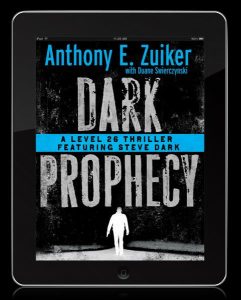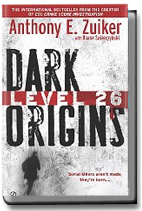Author’s Note: I was neither the director nor the director of photography on this project. As an employee of Dare to Pass, I’ve had the fortunate opportunity to have Anthony E. Zuiker as my boss and be a part of the Dark Prophecy project since the beginning. In addition to currently serving as the editor, I was also able to operate the second camera on 95% of the shoot as well as play a part in bringing the production to fruition.
That said, what is laid out below is my impression of working with the Canon 5D on this shoot in particular, both its ups and downs (though there were relatively few downs) and how it impacted what was a very packed production schedule. Enjoy!
When I first started working for Dare to Pass, the first Digi-novel, Level 26: Dark Origins, had already been released. For the previous cyber-bridges, they shot on the RED, which delivered some really amazing looking footage but handicapped them somewhat by the amount of lighting required.
I’m a huge fan of the RED camera and have used it to great success on a number of projects (even without the new MX sensor, which has much greater latitude and much better low-light performance) but I recognize that you do need to provide lighting and treat it more like film. In fact, I see the RED more of a less-expensive 35mm replacement than a wondercam that can shoot in no light and get an image. It’s not that. You have a lot of latitude in post shooting 4k RAW but you still need to give the image something to capture and to do so requires light, and in some cases, a lot of it. So, it’s no wonder they had to bring in a lot of lights and for those unfamiliar with film sets, a lot of lights means a lot of time setting them up.
We knew that Anthony was looking to go in a different direction on this one. We also knew that we had some budget concerns, cutting it nearly in half from Dark Origins. The result: a shorter shooting schedule, five days instead of ten, less money to pay to rent cameras and less money to spend on lights. They wanted to spend more time shooting and less time lighting, which is the dream of any director.
So, we came up with the idea of shooting this project on the Canon 5D. Having used it before on other projects, I was very aware of its low-light capability and amazingly shallow depth of field. By going with the 5Ds we could probably shoot on two cameras, doubling the amount of footage we’d be able to capture, while staying at a relatively low budget (camera department wise). Also, because of it’s low-light capability, we would require less lights, which means less lighting time, which means more time shooting, which = happy boss.
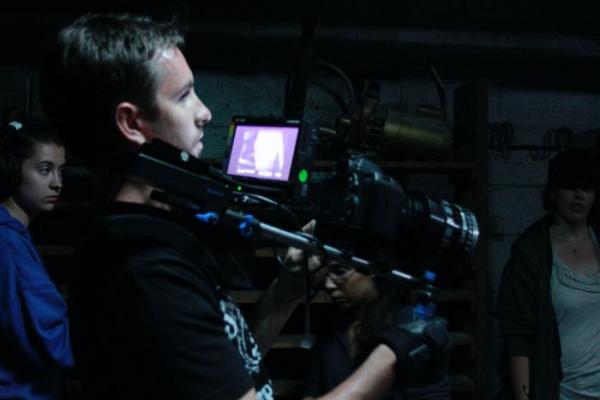
Now, that doesn’t mean you don’t have to light. Of course you do. It just means you can bring in a china ball instead of a 1k, you can use source lighting like lamps and candles and so on, instead of a ring of lights around the set, it means you can shoot on a rooftop in downtown LA, at night, and use a single Kino tube. Lighting is just as much of a tool as set design, camera framing and focus, and the best thing you can do, is use light to sculpt your image. You just don’t need a generator to do it.
So, I suggested that we bring in Will Eubank, a director of photography I know very well, who recently shot the Angels and Airwaves “Hallucinations” music video on the 5D, which you can see HERE. I knew he had the know how and experience to see the 5D through this project.
The other cool thing about Will is that he had, in his possession, a set of one-of-a-kind cine mounts for the 5D, letting him use cine lenses, rather than the more typical photography lenses. Typically, on the 5D you have to use photography lenses, but using cine-lenses gives you even more of a cinematic look and a really shallow depth-of-field. With Will on board we briefly discussed shooting the 7D vs. 5D vs. 1D. We ultimately settled on the 5D for several reasons, the main one being the full size sensor (as opposed to the smaller sensors on the 7D and 1D) as well the more video friendly aspect of the 5D.
In the process of doing my own research on the 5D, as I’ve never used the camera on something of this scale, I came upon Phillip Bloom, his great website, his Twitter account, as well as one of his specific posts about using the 5D on George Lucas’ new film Red Tails. You can read that post HERE.
I was mainly concerned about the camera’s “production-friendliness” or lack thereof. I knew that we’d be going out to a director’s monitor for both cameras and had heard rumors about losing the on-camera monitor when you did so. That was confirmed in Bloom’s post:
“The major issue we had with the Canons was the monitoring issue. These cameras are still cameras first and foremost and that causes many issues, one of the biggest is they all use a mini HDMI as it primary video out, which also causes the camera LCD to shut off. We experimented with using powered HDMI splitters to feed both the Marshall monitors for my focus puller and myself but also for video village. This was not very successful at all for our purposes.
For a small crew using the excellent Jag35 splitter we used would have been fine but we had to go a different more pro route. So what we ended up doing was using a Blackmagic HDMI to HD-SDI convertor. This required different monitors as our Marshalls were HDMI only but it did mean it slipped into the video village feed so much easier than before. This I have to say is essential in any serious production. Dump the HDMI and go HD-SDI, HDMI is a not a pro connection systems and suffers because of it. It just is not robust enough.
The big issue we had with the 5DmkII (the 7D and 1DmkiV were unaffected) was that when you hit record then the image drops from 1080i to 480p making using the monitor for focus a major issue and also caused about a 7 second black image for the director in video village. Not great. The new firmware for the 5DmkII has not rectified this issue.” (PhillipBloom.net)
Since we would definitely be going out to director’s monitors we would now have to get on-boards in order to have an image while Will and I operated.
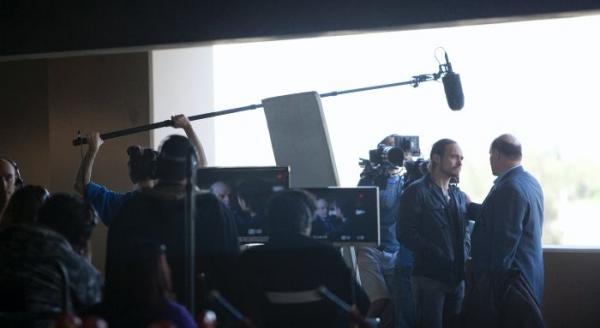
We decided that this would have to be more than us holding the stock cameras. Alan Gordon Enterprises provided us with a pretty decent handheld rig that included 7″ Marshall on-board monitors; Red Rock Eyespy shoulder rigs with follow focus, and HDMI splitters going out to HDMI monitors. You can see several pictures of the rig below.
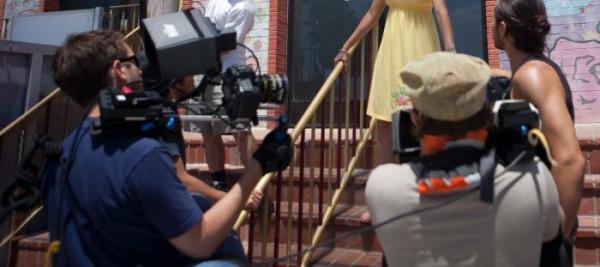
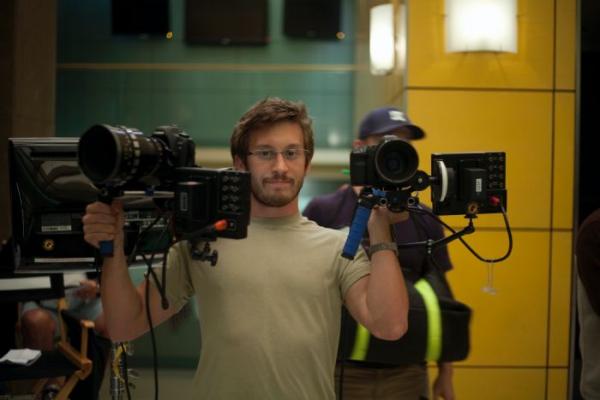
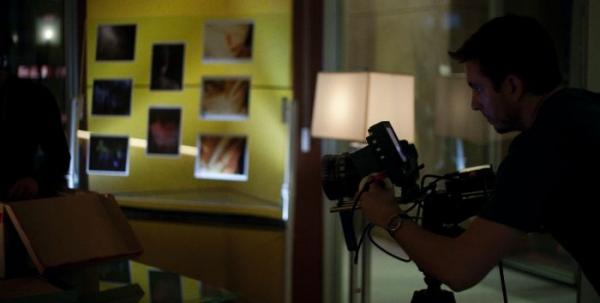
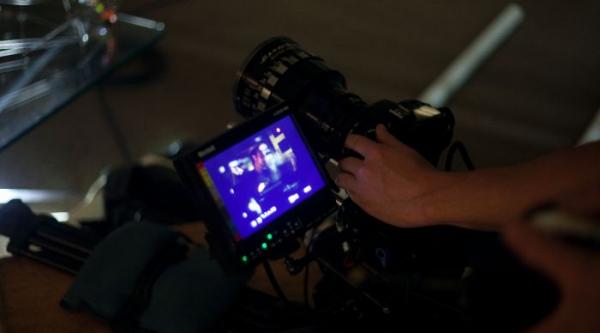
It was an incredibly awkward rig to operate. Very, very front heavy. Because we preferred to not attach the monitor via the camera shoe, we had to use arms to mount it. Only problem was that they were only so long, so the monitor ended up being a little too close to our faces, which strained our necks a bit and could get rather uncomfortable on long takes.
We also suffered the same problems Bloom did with regard to the down-rezzing when rolling. When going out to a monitor of any kind, the image is automatically downsized to 480p. For Anthony, this didn’t make a huge difference, since the image he was seeing on the monitors was never final. But it did hurt Will and I with focus (though, I admit, Will has much more experience pulling his own focus than I do) but after a day we got use to finding it in the monitor and it wasn’t really a problem anymore.
Though we had a Bartek (wireless focus system) with us and camera assistants, Will and I did almost all of our own focus pulling. And, we rarely, if ever set marks. We certainly never set focus marks, if anything it was for the actors. It helped that the nature of the project, and the shooting style employed, allowed for buzzing focus and handheld movement. It suited the look of the film, so we were never worried about it being perfect. Funny enough, about halfway through filming my monitor only worked in black and white, which actually made it easier to find the focus while shooting.
One of the other issues was that the monitor relay system we worked off of was HDMI. Unfortunately, HDMI can only carry an unpowered signal 25 ft. before it needs to be boosted. Thus, our monitors could only be, at most, 20 feet away from us (to allow for the cables being tied to the rig and monitor stands, as well as the length taken up by the cable running from us, to the floor and then up to the monitor). Fortunately, our sets were fairly small, so we were able to work around it or, in the case of very wide shots, Anthony would check out the image on our on-boards before rolling.
The better solution to this is to go with Bloom’s method of using HD-SDI. But HDMI was what Alan Gordon had, so it’s what we used.
Perhaps one of the greatest benefits we got from shooting on the Canon 5D was speed. By the end of our six-day shoot we had done 387 setups. We were almost never waiting on cameras or lighting. (Of course, that had a lot to do with some pre-rigging, not to mention the fact that we were shooting on pre-lit stages.) Regardless, once lighting was set, we were solid, aside from bringing in a bounce or adjusting a small light.
The majority of lighting was accomplished from sources, usually built into the sets. The sixth day, however, we shot on Willows Stages in East LA, which pretty much had zero built-in lighting. The day before shooting we had our crew in there pre-rigging and setting up lights. Ironically, in a number of cases, they had brought in too much light and it had to be scaled back.
At one point, while shooting only A camera, I grabbed an HVX to shoot some behind the scenes footage. The image was pretty much unusable because it was so dark. We had Alex Minkin, a very talented photographer, on set shooting additional behind the scenes stills. Since he was on the 5D as well, I had him shoot as much behind the scenes video as he could. At one point he came to me and said that he needed to go get a faster lens, since the f/2.8 he was using wasn’t giving him enough light, even though on our cameras with the Panavision lenses the image was more than bright enough! Insane!
For a rooftop scene in the middle of the night, we employed a single Kino tube, china ball and bounce. In one instance, I was shooting b-roll of our lead actor, Dan Buran, moving through this dungeon-like area. The set was incredibly dark but I managed to get away with it using only one Kino tube that was an existing light source in the basement, a practical flashlight and a bounce board.
Our lenses opened up to a 1.6 (for the 75mm and 100mm) and a 1 (for the 50mm, which we used for almost the entire shoot). We shot wide open the entire time. Our shutter speed, which was often adjusted depending on the lighting, was often set between 60 and 125. Our ISO lived anywhere from 100 (for the outdoor stuff in Venice) to 2500 (for some of the much darker scenes). Having seen the footage as it’s being process into FCP, I can tell you I see almost no noise.
Now, obviously one of the things we kept in mind throughout the shoot was the destination for the material. More than likely, it will live in no bigger form than the iPad. Knowing that, it can greatly affect the settings you decide to use and certainly allows you to get away with a lot more than you could if this were being shown on a big screen.
This camera, to me, feels like such a bigger revolution for the web-series, no-budget short film crowd. While I know people have shot features on it, it’s not the most production friendly camera. But it delivers stunning images, without the need for massive amounts of lighting, for very little money. The image really does look amazing. You get a lot of bang for your buck when it’s you with a camera shooting in downtown LA at night. But it does have a few issues when you start stepping into a more professional production setting. (Hopefully, realizing the impact this camera is having, Canon will address the monitor issue in their next firmware update.)
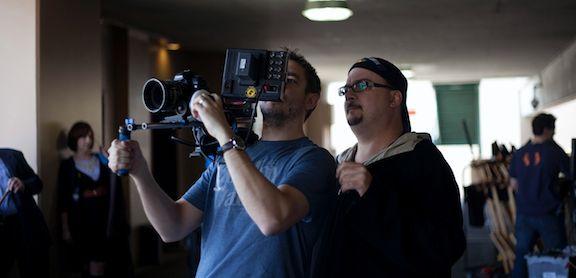
Ultimately, this camera was the perfect solution for this project. I do not believe that the Canon 5D is a RED-killer. Like all of these cameras, they are merely tools towards serving your needs as a filmmaker. Shooting a no-budget that takes place mostly at night? The Canon 5D might be perfect. Shooting a budgeted short that (you hope) will be shown in theatres? The RED MX might be a better choice. Shooting a Hollywood film for 100 million? Probably shooting on 35mm.
All of them will look good. And ultimately, this is all for us, the filmmakers. The audience probably won’t even notice. Because it doesn’t matter what you’re shooting on, it matters what story you’re telling and how well you tell it.
Be sure to check out Dark Prophecy: A Level 26 Thriller Featuring Steve Dark available on October 14th, 2010. In the meantime, stay tuned for more on the editing process as well as a trailer and photos.

